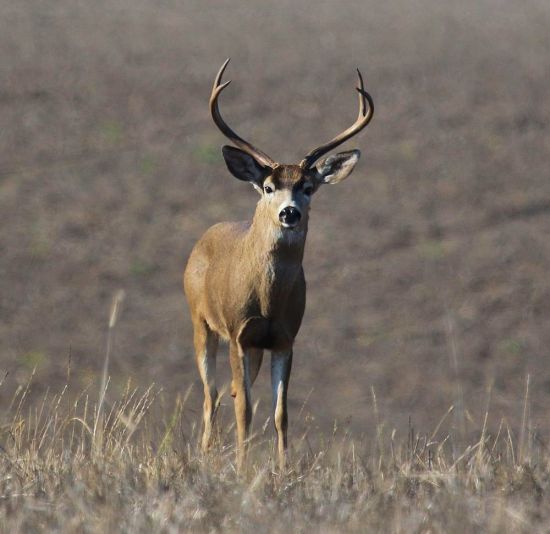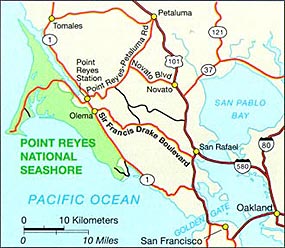| This article is incomplete. This article is missing one or more sections. You can help the BirdForum Opus by expanding it. |

Photo © by Higheagle
Crossing the Prairie near the shoreline at Point Reyes, 10 October, 2015
Overview
A windswept peninsula on the California coast just north of San Francisco, Point Reyes is one of the best migrant traps in the western United States. Protected as a National Seashore, the beaches and craggy shorelines are in relatively pristine condition. Some are inaccessible except by boat, which makes them excellent habitat for a variety of nesting pelagics.
Birds
Notable Species
Snow Goose, Ross's Goose, Greater White-fronted Goose, Brant, Cackling Goose, Tundra Swan, Wood Duck, Blue-winged Teal, Cinnamon Teal, Northern Shoveler, Gadwall, Eurasian Wigeon, American Wigeon, Mallard, Northern Pintail, Green-winged Teal, Canvasback, Redhead, Ring-necked Duck, Tufted Duck, Greater Scaup, Lesser Scaup, Canada Goose, Harlequin Duck, Surf Scoter, White-winged Scoter, Black Scoter, Long-tailed Duck, Bufflehead, Common Goldeneye, Barrow's Goldeneye, Hooded Merganser, Common Merganser, Red-breasted Merganser, Ruddy Duck, California Quail, Pied-billed Grebe, Horned Grebe, Red-necked Grebe, Eared Grebe, Western Grebe, Clark's Grebe, Band-tailed Pigeon, White-winged Dove, Mourning Dove, Lesser Nighthawk, Common Nighthawk, Common Poorwill, Mexican Whip-poor-will, Black Swift, Chimney Swift, Vaux's Swift, White-throated Swift, Yellow-billed Cuckoo, Black-chinned Hummingbird, Anna's Hummingbird, Costa's Hummingbird, Calliope Hummingbird, Rufous Hummingbird, Allen's Hummingbird, Ridgway's Rail, Virginia Rail, Sora, Common Gallinule, American Coot, Yellow Rail, Sandhill Crane, Black-necked Stilt, American Avocet, Black Oystercatcher, Black-bellied Plover, American Golden-Plover, Pacific Golden-Plover, Snowy Plover, Semipalmated Plover, Killdeer, Mountain Plover, Whimbrel, Long-billed Curlew, Marbled Godwit, Ruddy Turnstone, Black Turnstone, Red Knot, Surfbird, Ruff, Sharp-tailed Sandpiper, Stilt Sandpiper, Sanderling, Dunlin, Rock Sandpiper, Baird's Sandpiper, Least Sandpiper, Buff-breasted Sandpiper, Pectoral Sandpiper, Semipalmated Sandpiper, Western Sandpiper, Short-billed Dowitcher, Long-billed Dowitcher, Wilson's Snipe, Wilson's Phalarope, Red-necked Phalarope, Red Phalarope, Spotted Sandpiper, Solitary Sandpiper, Wandering Tattler, Greater Yellowlegs, Willet, Lesser Yellowlegs, South Polar Skua, Pomarine Jaeger, Parasitic Jaeger Long-tailed Jaeger, Common Murre, Pigeon Guillemot, Marbled Murrelet, Craveri's Murrelet, Ancient Murrelet, Cassin's Auklet, Rhinoceros Auklet, Horned Puffin, Tufted Puffin, Black-legged Kittiwake, Sabine's Gull, Bonaparte's Gull, Laughing Gull, Franklin's Gull, Heermann's Gull, Short-billed Gull, Ring-billed Gull, Western Gull, California Gull, American Herring Gull, Glaucous-winged Gull, Glaucous Gull, Least Tern, Caspian Tern, Black Tern, Common Tern, Arctic Tern, Forster's Tern, Royal Tern, Elegant Tern, Black Skimmer, Red-throated Loon, Pacific Loon, Common Loon, Black-footed Albatross, Wilson's Storm-Petrel, Fork-tailed Storm-Petrel, Leach's Storm-Petrel, Ashy Storm-Petrel, Black Storm-Petrel, Northern Fulmar, Murphy's Petrel, Mottled Petrel, Pink-footed Shearwater, Flesh-footed Shearwater, Buller's Shearwater, Sooty Shearwater, Short-tailed Shearwater, Black-vented Shearwater, Wood Stork, Brown Booby, Brandt's Cormorant, Pelagic Cormorant, Double-crested Cormorant, American White Pelican, Brown Pelican, American Bittern, Least Bittern, Great Blue Heron, Great Egret, Snowy Egret, Little Blue Heron, Western Cattle Egret, Green Heron, Black-crowned Night-Heron, White-faced Ibis, Turkey Vulture, Osprey, White-tailed Kite, Golden Eagle, Northern Harrier, Sharp-shinned Hawk, Cooper's Hawk, American Goshawk, Bald Eagle, Red-shouldered Hawk, Broad-winged Hawk, Swainson's Hawk, Zone-tailed Hawk, Red-tailed Hawk, Rough-legged Hawk, Ferruginous Hawk, American Barn Owl, Western Screech-Owl, Great Horned Owl, Northern Pygmy-Owl, Burrowing Owl, Barred Owl, Long-eared Owl, Short-eared Owl, Northern Saw-whet Owl, Belted Kingfisher, Williamson's Sapsucker, Yellow-bellied Sapsucker, Red-naped Sapsucker, Red-breasted Sapsucker, Lewis's Woodpecker, Acorn Woodpecker, Downy Woodpecker, Nuttall's Woodpecker, Hairy Woodpecker, White-headed Woodpecker, Pileated Woodpecker, Northern Flicker, American Kestrel, Merlin, Peregrine Falcon, Prairie Falcon, Olive-sided Flycatcher, Western Wood-Pewee, Willow Flycatcher, Least Flycatcher, Hammond's Flycatcher, Gray Flycatcher, Dusky Flycatcher, Western Flycatcher, Black Phoebe, Eastern Phoebe, Say's Phoebe, Vermilion Flycatcher, Ash-throated Flycatcher, Tropical Kingbird, Cassin's Kingbird, Western Kingbird, Eastern Kingbird, Scissor-tailed Flycatcher, Bell's Vireo, Hutton's Vireo, Cassin's Vireo, Plumbeous Vireo, Philadelphia Vireo, Warbling Vireo, Red-eyed Vireo, Loggerhead Shrike, Northern Shrike, Pinyon Jay, Steller's Jay, California Scrub-Jay, Yellow-billed Magpie, Clark's Nutcracker, American Crow, Common Raven, Mountain Chickadee, Chestnut-backed Chickadee, Oak Titmouse, Horned Lark, Northern Rough-winged Swallow, Purple Martin, Tree Swallow, Violet-green Swallow, Bank Swallow, Barn Swallow, Cliff Swallow, Bushtit, Wrentit, Ruby-crowned Kinglet, Golden-crowned Kinglet, Red-breasted Nuthatch, White-breasted Nuthatch, Pygmy Nuthatch, Brown Creeper, Blue-gray Gnatcatcher, Rock Wren, Canyon Wren, House Wren, Pacific Wren, Marsh Wren, Bewick's Wren, American Dipper, European Starling, Gray Catbird, Brown Thrasher, Bendire's Thrasher, California Thrasher, Sage Thrasher, Northern Mockingbird, Western Bluebird, Mountain Bluebird, Townsend's Solitaire, Varied Thrush, Swainson's Thrush, Hermit Thrush, American Robin, Bohemian Waxwing, Cedar Waxwing, Phainopepla, American Pipit, Evening Grosbeak, House Finch, Purple Finch, Cassin's Finch, Red Crossbill, Pine Siskin, Lesser Goldfinch, Lawrence's Goldfinch, American Goldfinch, Lapland Longspur, Chestnut-collared Longspur, Thick-billed Longspur, Grasshopper Sparrow, Chipping Sparrow, Clay-colored Sparrow, Black-chinned Sparrow, Brewer's Sparrow, Black-throated Sparrow, Lark Sparrow, Lark Bunting, American Tree Sparrow, Fox Sparrow, Dark-eyed Junco, White-crowned Sparrow, Golden-crowned Sparrow, Harris's Sparrow, White-throated Sparrow, Vesper Sparrow, Nelson's Sparrow, Savannah Sparrow, Song Sparrow, Lincoln's Sparrow, Swamp Sparrow, California Towhee, Rufous-crowned Sparrow, Green-tailed Towhee, Spotted Towhee, Yellow-breasted Chat, Yellow-headed Blackbird, Bobolink, Western Meadowlark, Orchard Oriole, Hooded Oriole, Bullock's Oriole, Baltimore Oriole, Scott's Oriole, Red-winged Blackbird, Tricolored Blackbird, Brown-headed Cowbird, Brewer's Blackbird, Great-tailed Grackle, Ovenbird, Northern Waterthrush, Black-and-white Warbler, Prothonotary Warbler, Tennessee Warbler, Orange-crowned Warbler, Lucy's Warbler, Nashville Warbler, Virginia's Warbler, MacGillivray's Warbler, Kentucky Warbler, Common Yellowthroat, Hooded Warbler, American Redstart, Northern Parula, Magnolia Warbler, Bay-breasted Warbler, Blackburnian Warbler, Yellow Warbler, Chestnut-sided Warbler, Blackpoll Warbler, Black-throated Blue Warbler, Palm Warbler, Yellow-rumped Warbler, Black-throated Gray Warbler, Townsend's Warbler, Hermit Warbler, Black-throated Green Warbler, Canada Warbler, Wilson's Warbler, Painted Redstart, Summer Tanager, Western Tanager, Rose-breasted Grosbeak, Black-headed Grosbeak, Blue Grosbeak, Lazuli Bunting, Indigo Bunting, Painted Bunting and Dickcissel.
A full list of birds can be found at https://www.nps.gov/pore/learn/nature/upload/animalspecieslist_bird.pdf
Rarities
Point Reyes is one of the most reliable sites in California for stray warblers, vireos, and thrushes from the forests of eastern North America: Tennessee, Chestnut-sided, Magnolia, Black-throated Blue, Palm, Blackpoll, and Black-and-white Warblers are annual.
Sensitive and protected species under study at Pt. Reyes are the Snowy Plover and Northern Spotted Owl
The point's Siberian vagrants have included Red-throated Pipit, Yellow and Black-backed Wagtails, Dusky Warbler, Eurasian Skylark and Brown Shrike.
Check-list
A full, linked bird list (.pdf format) to the 490 species present (seasonally dependent) can be found here.
Other Wildlife
Notable mammals of Point Reyes include Northern Elephant Seal Mirounga angustirostris, Gray Whale Eschrichtius robustus, Mountain Lion Puma concolor, and Tule Elk Cervus canadensis nannodes.
Site Information
History and Use
"to do"
Areas of Interest
Abbott's Lagoon is accessible from the parking lot on the left side of Pierce Point Road, a few miles north of the intersection with Sir Francis Drake Boulevard. (Look for the single large tree shading the parking lot.) The trail runs from the parking lot trailhead to the beach beyond the lagoon. Typical species found in the coastal scrub here are White-crowned Sparrow, American Goldfinch, California Quail, Say's Phoebe, American Pipit, and Northern Harrier. The section of trail immediately beyond the parking lot is one of the most reliable places in northern California to find Palm Warblers. Patient observation may be rewarded with a Virginia Rail lurking in any of the patches of freshwater marsh along the trail. The lagoon itself often holds American White Pelican, many species of ducks, herons, and egrets, and a variety of shorebirds, notably including the August passage of Red-necked Phalaropes. The sandy beach beyond the lagoon at the ocean end of the trail is fenced off in summer to protect nesting Snowy Plovers.
Five Brooks trailhead is located on California Highway 1 about four miles south of Olema. The principal trail here is a loop around a small pond that serves as a junction for several trails leading deeper into the woods of the Inverness Ridge. The pond is a regular site for nesting Wood Ducks as well as Common Gallinules. The trees around the pond are home to typical species of coniferous forest, including Winter Wren, Steller's Jay, and Western Flycatcher.
At the end of Sir Francis Drake Boulevard is the Lighthouse perched on a narrow fin of rock, and accessible only by foot. The parking lot (often full on weekends and during the winter whale-watching season) is about 1/4 mile hike from the upper visitors' area, where there is a small cluster of historical buildings with displays. Some 300 feet below, the lighthouse can only be reached via a steep flight of hundreds of stairs.
This spot is the windiest and the second foggiest on the California coast, with typical temperatures 20 degrees (F) lower than the main population centers inland. Birding can be difficult or unpleasant because of weather conditions. However, on a good day, expect to see Brandt's and Pelagic Cormorants, scoters (mostly Surf), and most of the Pacific sea ducks riding the waves below, raptors such as Red-tailed Hawk, and migrant songbirds along the hike to the station, all within their respective seasons. Seals are typically hauled out on the rocks at the base of the cliffs, but note that all these are at considerable distance; you are still 300' above sea level at the lighthouse, and further descent is impossible. Also visible from the observation platforms is a large nesting colony of Common Murres.
Just before the lighthouse a narrow road turning off Sir Francis Drake Boulevard leads to the parking lot for Chimney Rock. The trail overlooking the headlands here offers easier observation of rocky shoreline species such as Black Oystercatcher, Black Turnstone, and Surfbird, as well as alcids such as Rhinoceros Auklet. The sheltered bay to the north of the rock will often contain loons, grebes, and Surf Scoters as well as Elephant Seals. The trees surrounding the "Fish Docks" on the north side of the point are an excellent location for vagrant passerines between August and October. In other seasons almost every passerine found here will be one of the abundant nesting Savannah Sparrows.
Other places of interest:
Drake's Beach, Mendoza and Nunes Ranches.
Access and Facilities
National Seashore, 38°4′N 122°53′W. 71,028-acre (287.44 km2) "to do"
Contact Details
National Park Service.
References
- https://avibase.bsc-eoc.org/checklist.jsp?region=USca09
- https://en.wikipedia.org/wiki/Point_Reyes_National_Seashore,_California
Recommended Citation
- BirdForum Opus contributors. (2025) Point Reyes National Seashore. In: BirdForum, the forum for wild birds and birding. Retrieved 15 May 2025 from https://www.birdforum.net/opus/Point_Reyes_National_Seashore
External Links
GSearch checked for 2020 platform.1




